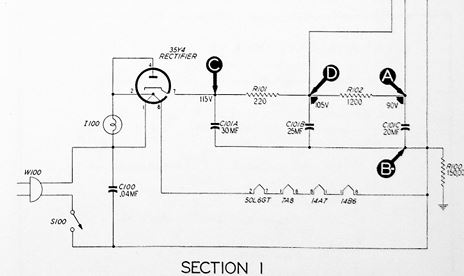8 hours ago
Hi Gang,
Tube heaters are not "Ohmic" devices (that maintain specified resistance over wide temperature, current, etc.). They start out at a very low resistance and draw a lot of current. If you observe the filaments, it is possible that you will see a similar but less dramatic effect on some of the tubes. Every AA5 set I have with a pilot light behaves the same way, with the bulb getting very bright at turn on, dimming as the tubes warm up and then getting brighter as the rectifier starts conducting.
As for fusing, most sets using a 35Z5, 35W4 or 35Y4 (the ones with the tapped filament heater) puts the rectifier plate (and the B+ load on the tap. A short in the B+ or heaters in the other tubes would blow the section of the 35Z5 heater between the power input and the plate (and also the pilot lamp).
Attached below is the Power Supply section of my 47-205 that uses a 35Y4 in the manner described above. No resistors are used because the convertor, IF and detector / 1st AF are 14V tubes, so the total filament voltage of the string is 127V nominal. See below:

In your set, the 35Z3(a Loctal) tube does not have the tap that a 35Z5 does. In addition, since the convertor, IF and detector / 1st AF tubes are 7V types, you need the 120 Ohms that the Candohm resistor, #27A / 27B provides. Since the 35Z3 is part of the heater string, pulling the tube not only breaks the B+, it breaks the filament string, therefore no current will flow and the pilot remains off. IMHO, the Candohm acts as a fuse (albeit an expensive and had to replace one) in a manner similar to a 35Z5 filament as described above.
Hope this helps.
Tube heaters are not "Ohmic" devices (that maintain specified resistance over wide temperature, current, etc.). They start out at a very low resistance and draw a lot of current. If you observe the filaments, it is possible that you will see a similar but less dramatic effect on some of the tubes. Every AA5 set I have with a pilot light behaves the same way, with the bulb getting very bright at turn on, dimming as the tubes warm up and then getting brighter as the rectifier starts conducting.
As for fusing, most sets using a 35Z5, 35W4 or 35Y4 (the ones with the tapped filament heater) puts the rectifier plate (and the B+ load on the tap. A short in the B+ or heaters in the other tubes would blow the section of the 35Z5 heater between the power input and the plate (and also the pilot lamp).
Attached below is the Power Supply section of my 47-205 that uses a 35Y4 in the manner described above. No resistors are used because the convertor, IF and detector / 1st AF are 14V tubes, so the total filament voltage of the string is 127V nominal. See below:
In your set, the 35Z3(a Loctal) tube does not have the tap that a 35Z5 does. In addition, since the convertor, IF and detector / 1st AF tubes are 7V types, you need the 120 Ohms that the Candohm resistor, #27A / 27B provides. Since the 35Z3 is part of the heater string, pulling the tube not only breaks the B+, it breaks the filament string, therefore no current will flow and the pilot remains off. IMHO, the Candohm acts as a fuse (albeit an expensive and had to replace one) in a manner similar to a 35Z5 filament as described above.
Hope this helps.
"Do Justly, love Mercy and walk humbly with your God"- Micah 6:8
"Let us begin to do good"- St. Francis
Best Regards,
MrFixr55



![[-] [-]](https://philcoradio.com/phorum/images/bootbb/collapse.png)


